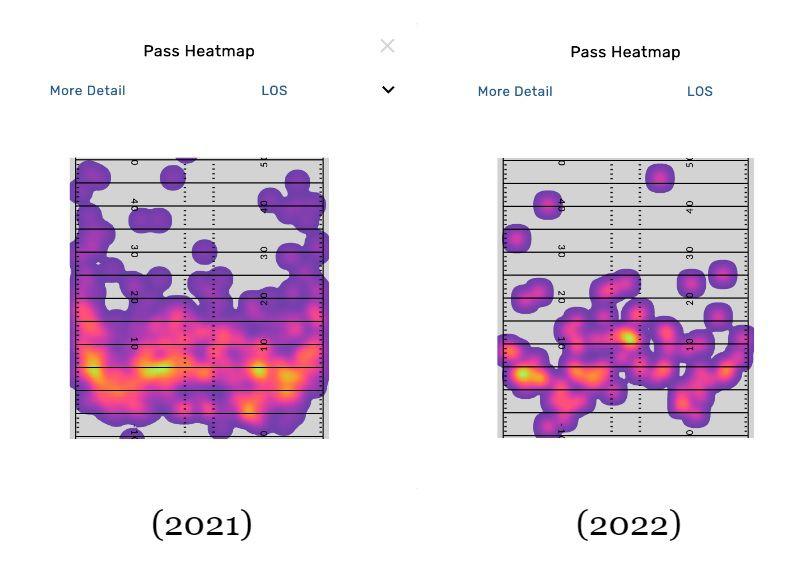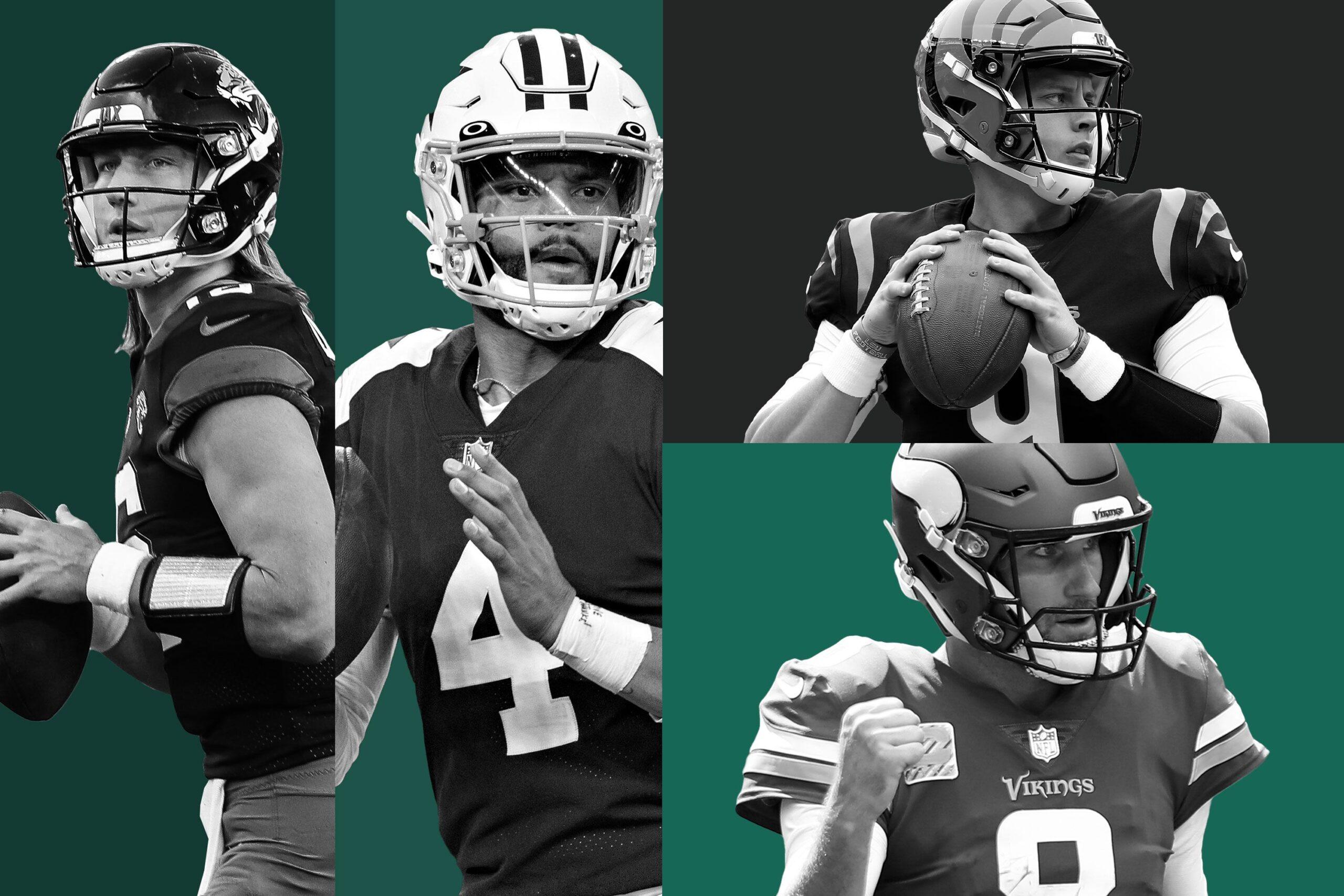What to most of us came as an unexpected performance by Tua Tagovailoa was not surprising, Mike McDaniel said. Even after a record-setting comeback and a passing output equaled only by Dan Marino in franchise history, the Miami Dolphins head coach said Tagovailoa hadn’t done anything that the team didn’t already know the quarterback was capable of doing.
“No one was like, ‘Whoa, dude, where’d that come from?’” McDaniel said.
That refers to Tagovailoa’s six-touchdown, 469-yard performance against the Baltimore Ravens in a 42-38 comeback win Sunday. Both the touchdowns and the passing yardage were career highs for the third-year pro.
“It’s good for y’all to see, but we kind of expect that,” wide receiver Jaylen Waddle said.
OK, but come on. Tagovailoa had never played like that before, and the fact that he’s shown marked improvement in the first two weeks of this season is a good thing for a Miami offense that needed significant development from its starting quarterback. The question now becomes whether a wider audience should share the Dolphins’ expectations. Maybe it’s unfair to expect Tagovailoa to drop 42 points on opponents weekly, but can the Dolphins sustain this explosive offense long enough to put the team in the mix among AFC playoff contenders?
First, the reasons for skepticism: Many of Tagovailoa’s best plays against the Ravens came in high-variance situations. Four of his six touchdowns came on third downs, and two came against busted coverages by Baltimore. Miami scored 28 of its 42 points in the fourth quarter, as injuries took a toll on the Ravens’ secondary. Baltimore was already without starter Brandon Stephens, and Marlon Humphrey was limited to just 11 fourth-quarter snaps.
But there’s still a clear reason to believe that the way Miami’s offense played Sunday, if perhaps not the outrageous stats and fourth-quarter magic, is replicable. Beyond simply showing off the speed of Waddle and Tyreek Hill, or Tagovailoa’s poise under pressure late in the game, the Dolphins offense showed that the combination of dynamic personnel, Tagovailoa’s skills as a passer, and McDaniel’s scheming can mesh together in a way that works.
It was not obvious coming into this season that it could. On a basic level, McDaniel came from a Kyle Shanahan–designed offense in San Francisco that has a long history of getting good production from quarterbacks without asking them to elevate the players around them. (In 2021, for example, the 49ers had the seventh-best offense by total yardage and ranked first in net yards per pass attempt despite asking their quarterbacks—mainly Jimmy Garoppolo, though Trey Lance threw 71 passes, as well—to attempt just 514 passes, which ranked 29th in the league and, in Garoppolo’s case, tied for 22nd in average depth of target.) Looking even more critically at the potential scheme fit between coach and quarterback, the Dolphins hired someone from a heavy play-action system where the quarterback is usually under center to coach Tagovailoa, who played 88 percent of his snaps out of shotgun formations in 2021. Tagovailoa ranked 29th in the NFL in average depth of target last year, and the Dolphins are now asking him to throw to two of the NFL’s fastest deep-ball threats, 2021 first-round draft pick Waddle and three-time All-Pro first-team pick Hill. The potential seemed there for Miami to wind up with some very fancy square pegs and a very fancy round hole.
Sunday’s performance against the Ravens was critical because it showed that all of those pieces can fit snugly together. Looking at the first two weeks of the Dolphins’ season, Miami has shown at least three major offensive developments that allow all the component parts to click.
The first is that Tagovailoa is throwing the ball deeper down the field than he ever has before. His average depth per target last year was 7.0 yards, worse than quarterbacks like Davis Mills and Daniel Jones. This year he’s tied for 15th among qualified passers, at an average of 7.8 yards. (If you had Tua throwing farther downfield than Josh Allen on your 2022 NFL bingo card, hats off to you.)
It’s not that the Dolphins are totally uncorking Tagovailoa, who doesn’t have the arm strength to be an elite deep-ball passer. But they’re not waving the white flag and having him dink and dunk around the line of scrimmage and rely solely on his playmakers to create after the catch. The result so far is that the Dolphins lead the NFL with 338 yards after the catch, but those plays are going for even more yards because of the air yards Tagovailoa is adding in the first place.
The effect is not only that Miami is able to move the ball in chunks, but also that the Dolphins are able to force defenses to spread out. This was probably always going to happen given the respect that defensive coordinators have for Hill’s and Waddle’s speed, but Tagovailoa is proving that he’s going to take some deeper drops and throw to the intermediate level of the field. This challenges opponents into covering even more territory, and you saw the impact on Sunday, as Hill and Waddle each averaged more than 3 yards of separation, according to Next Gen Stats. Tagovailoa even underthrew two touchdown passes to Hill, but the receiver had enough space to go back to get them.
A major issue for the Dolphins last season was how often Tagovailoa was throwing into tight windows, something he did a league-leading 19.3 percent of the time. So far this year, that figure has dropped to 8.4 percent, 28th among starting quarterbacks. (Next Gen Stats defines a tight-window throw as one to a receiver with less than a yard of separation from the nearest defender.) Tagovailoa’s accuracy and ball placement when not throwing deep rank among his strengths as a passer—McDaniel said recently that he throws “the most accurate, catchable ball I’ve ever seen”—so the issue wasn’t so much that he couldn’t make those throws but that they were going to receivers who didn’t have the space to turn upfield and extend the play. That has reversed significantly so far this season. Continuing to push the ball downfield more than they’ve done in the past has allowed Tagovailoa to take advantage of the playmakers around him and get them the ball in situations where they can add yards after the catch. Tagovailoa doesn’t have to turn into a deep-ball thrower (and he shouldn’t), but he has to keep forcing opponents to defend enough of the field so that space opens up throwing windows at every level of the field.
McDaniel’s ability to use spacing has unlocked the middle of the field for Tagovailoa. Look at the difference in his passing heat map, from TruMedia, from 2021 to his two games in 2022 and you’ll see a much larger glowing red dot between the hashes:

Tagovailoa is listed at 6-foot-1, on the smaller side for an NFL quarterback, and concerns that his size would limit his vision in the middle of the field were clearly borne out in his play last season. He didn’t appear comfortable throwing between the hashes. But when the defense can’t clog up the short and intermediate areas of the field, it creates open receivers and wider throwing lanes, which Tagovailoa has been able to take advantage of, as he did on this 33-yard completion to Waddle on the left hash against the Ravens:
The third significant change in the Dolphins offense under McDaniel is that they’ve almost entirely done away with the consistent but not explosive RPO-heavy offense they relied on heavily last season. They’ve replaced many of those RPOs with play-action, including play-action out of shotgun (as you saw in the clip above). This is a key development because it shows what this brand of a Shanahan offense looks like for Tagovailoa. In Shanahan’s scheme, play-action from under center is a core concept, but Tagovailoa and McDaniel have succeeded so far in running it with the quarterback in shotgun formations, as well.
According to TruMedia, Tagovailoa has taken 35 dropbacks using play-action, 13 of which came in shotgun. On those plays, Tagovailoa is 10-of-12 for 150 passing yards (with an average of 12.5 yards per attempt) with a touchdown, an interception, and a passer rating of 111.8. Those plays represent the marriage of the Shanahan scheme and Tagovailoa’s skill set and preferred playing style, and they’re working for Miami. Non-play-action dropbacks are working, too: Tagovailoa posted a league-high 0.57 expected points added on those plays in Week 2. The Dolphins were always going to need to find plays that worked to replace some of their RPO calls if they were going to become more explosive and take advantage of their personnel. So far, they have.
The best news for the Dolphins is that there should be more fruit on the vine. While the passing offense has exceeded expectations, Miami’s running game hasn’t been very exciting or dynamic. The Dolphins currently rank 25th in the NFL in yards per attempt at 3.7. This is despite the fact that their offensive line hasn’t been terrible, ranking 18th in ESPN’s run block win rate through two games. McDaniel came to Miami having been the run game coordinator for one of the league’s most productive rushing offenses, and he has two good, quick backs in Chase Edmonds and Raheem Mostert and a fullback in Alec Ingold who can assist with blocking duties should the offensive line struggle. The running game was supposed to be the thing that would buoy the Dolphins offense in the event that the passing game was disjointed, and if it starts to kick in as the offensive line jells and McDaniel gets in a groove as a first-time play caller, it will give Miami another card to play.
The big question now is whether this suddenly explosive Miami offense will make the Dolphins competitive this Sunday against their no. 1 nemesis, the Buffalo Bills. Miami has lost nine of its past 10 games to Buffalo (including playoffs), and was outscored by the Bills 61-11 in two games last season. And the 2022 Bills appear even stronger, having scored 72 points (and allowed just 17) in two games (both against 2021 playoff teams). But Miami is undoubtedly stronger offensively, too, and should enter this game with confidence in its overhauled offense. Miami is proving that this offense can work, and Tagovailoa can excel in it. If this year’s results continue to show that he’s more than capable of executing McDaniel’s scheme and creating explosive plays with Waddle and Hill, he should finally earn a greater commitment from the organization. Which, as they’re likely to say, they believed in all along.

